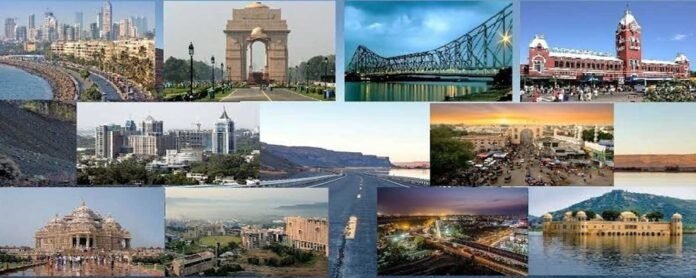Metro Cities in India: Metro rail systems have gained remarkable popularity as the primary mode of mass rapid transit in India, boasting an expansive operational network that spans over 835 kilometers and encompasses 15 major cities. Surprisingly, the inception of India’s first metro system dates all the way back to 1984, when Kolkata introduced its pioneering metro operations.
Metro Cities in India
A total of 17 Indian cities have embraced the convenience of an active metro rail service, each boasting its own operational metro map. The list of cities encompassing India’s metro route map includes Kolkata, Delhi, Chennai, Bengaluru, Hyderabad, Ahmedabad, Jaipur, Gurugram, Mumbai, Noida, Kochi, Lucknow, Nagpur, Kanpur, and Pune.
Among these urban centers, the honor of the largest and most extensive metro network in India belongs to the National Capital, Delhi. Interestingly, it was Kolkata that pioneered the concept of metro services in the country, with the inaugural service commencing in the year 1984. A closer examination of India’s metro network offers insights into the progressive transformation of urban transportation across these cities.
History of Metro Cities in India
The inception of metro rail systems in India originated with the establishment of the Kolkata Metro, which marked the country’s first underground metro operation in 1984. This milestone heralded the initiation of metro networks in other prominent Indian cities like Delhi, Mumbai, Chennai, Bengaluru, Hyderabad, Jaipur, Kochi, and Lucknow.
A blend of government entities and public-private collaborations has orchestrated the evolution of these metro networks. Key organizations that have shaped the development of metro rail in India include:
- Kolkata Metro: The pioneering Kolkata Metro Rail Corporation (KMRC) spearheaded the creation of the first-ever metro network in India, namely the Kolkata Metro.
- Delhi Metro: The Delhi Metro Rail Corporation (DMRC) played a crucial role in orchestrating the conceptualization, construction, and operationalization of the Delhi Metro. DMRC stands as a joint venture between the Government of India and the Government of the National Capital Territory of Delhi.
- Mumbai Metro: The Mumbai Metro Rail Corporation Limited (MMRCL) assumes responsibility for executing metro ventures in Mumbai. It operates as a collaborative effort between the Government of Maharashtra and the Government of India.
- Chennai Metro: Steering the establishment of the Chennai Metro, the Chennai Metro Rail Limited (CMRL) emerges as a significant player. CMRL operates as a joint venture uniting the Government of India and the Government of Tamil Nadu.
Underground Metro Systems in India
Several Indian urban centers boast subterranean metro systems, with notable instances comprising:
- Kolkata Metro: The Kolkata Metro predominantly operates as an underground metro network, interwoven with elevated sections. This system has significantly ameliorated urban mobility in the city. The initial concept of a subterranean metro in Kolkata was championed by Bidhan Chandra Roy, the then Chief Minister of West Bengal.
- Delhi Metro: The Delhi Metro encompasses both elevated and subterranean sections. The underground segments play a pivotal role in catering to densely inhabited regions within the city.
- Chennai Metro: The Chennai Metro also incorporates subterranean stretches, furnishing the city’s populace with streamlined commuting alternatives.
List of Metro Cities in India
India has witnessed a rapid expansion of metro rail networks across its cities, revolutionizing urban transportation and connectivity. Introducing metro systems has brought convenience and efficiency to commuters’ lives, reducing travel time and traffic congestion. Here is a comprehensive list of Indian cities that have embraced metro connectivity to cater to the needs of their citizens:
- Delhi – Delhi Metro Rail Corporation (DMRC)
- Mumbai – Mumbai Metro Rail Corporation Limited (MMRC)
- Bengaluru – Namma Metro
- Hyderabad – Hyderabad Metro Rail
- Chennai – Chennai Metro Rail (CMRL)
- Kochi – Kochi Metro Rail Limited
- Jaipur – Jaipur Metro Rail Corporation Ltd (JMRC)
- Kolkata – Kolkata Metro Rail Corporation Ltd (KMRC)
- Lucknow – Lucknow Metro Rail Corporation (LMRC)
- Noida – Noida Metro Rail Corporation Ltd (NMRC)
- Gurgaon – Rapid Metro Gurgaon
- Nagpur – Nagpur Metro Rail
- Ahmedabad Metro
- Noida Aqua Line Metro
- Pune Metro
- Kanpur Metro
- Delhi-Meerut Regional Rapid Metro
Recommended Articles:
List of Top 16 Richest Cricketers In the World – Highly Paid Cricketers
Top 10 Richest People in India in 2024
ICC ODI World Cup Winners List from 1975 to 2023, Australia Wins World Cup 2023
Complete IPL Winners List from 2008 to 2023
T20 World Cup Winners List from 2007 to 2023
Top 10 Powerful Countries In The World By Military Strength 2024
List of Metro Cities in India FAQs
What is the significance of metro rail systems in India?
Metro rail systems have significantly transformed urban transportation, providing efficient and rapid mass transit options across major cities in India.
When did India's first metro system commence operations?
India's first metro system began operations in 1984 in Kolkata, marking the inception of metro networks in the country.
Which Indian city has the largest metro network?
Delhi, the National Capital, boasts the largest and most extensive metro network in India.
Who played a pivotal role in the development of the Delhi Metro?
The Delhi Metro Rail Corporation (DMRC), a joint venture between the Government of India and the Government of the National Capital Territory of Delhi, played a crucial role in planning, constructing, and operating the Delhi Metro.
Which cities have underground metro systems in India?
Cities like Kolkata, Delhi, and Chennai have underground metro systems, which provide efficient transportation options for densely populated areas.
